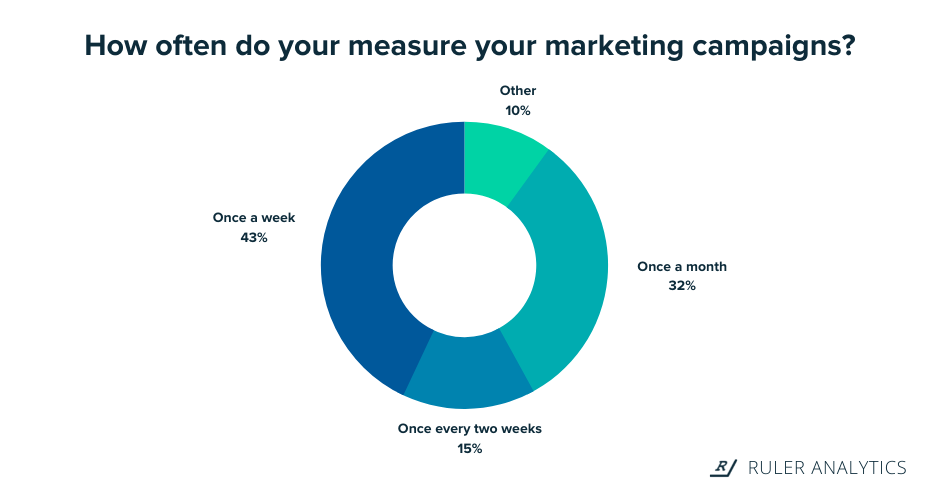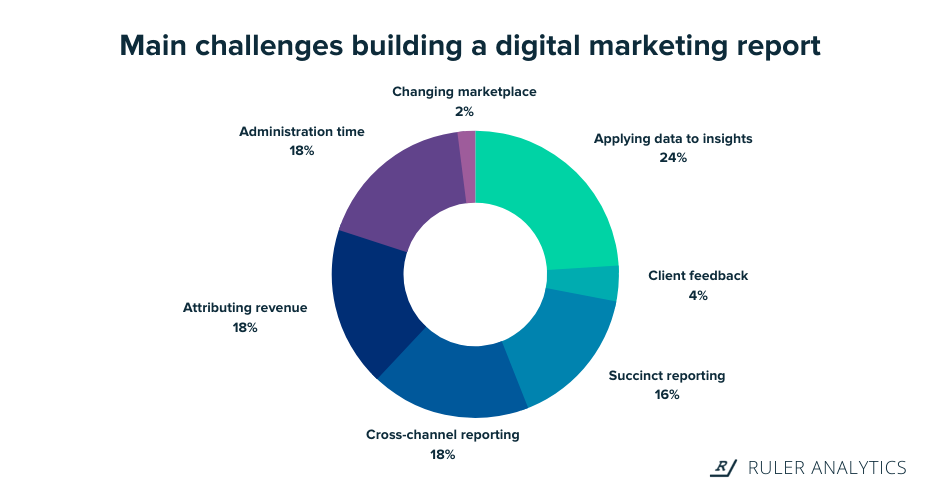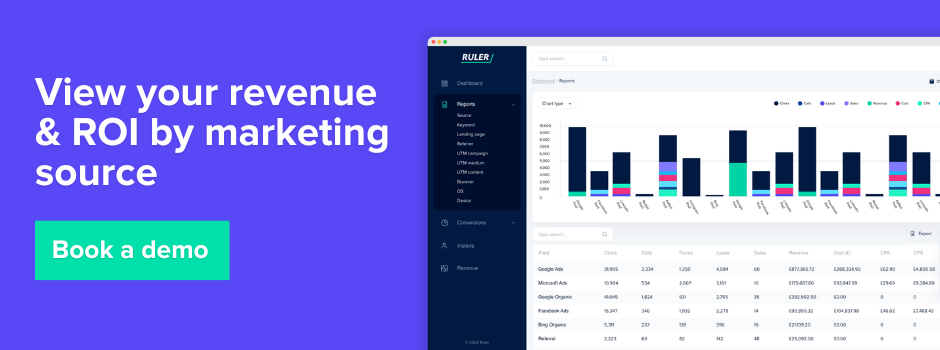A digital marketing report allows you to evaluate performance and uncover key insights to optimise for campaign success.
If you’re looking for a guide that tells you everything you need to know about digital marketing reports, look no further.
We asked a number of experts for their top tips on creating digital marketing reports.
And, using their insights, we’ve listed exactly what you need to create powerful and thorough digital marketing reports that’ll blow away your stakeholders and clients.
Here’s what you’ll learn:
💡 Pro Tip
Ruler measures marketing performance by tracking the user’s journey from the first interaction to conversion, using click path data to analyse how various touchpoints contribute to generating leads and revenue. When unique identifiers are unavailable, machine learning models estimate impressions and associate them with revenue, enabling reattribution and assessment of the impact of top-of-funnel activities.
Take your measurement to the next level with a demo
Chances are you know what a digital marketing report is, but to cover our bases, let’s quickly break it down.
A digital marketing report is a document used to monitor the performance of a specific marketing campaign or effort and uncovers important insights to inform future decision making.
Related: How to measure your marketing performance
“It’s an opportunity for stakeholders to see a snapshot of how a channel is performing,” added James Brockbank, Managing Director at Digitaloft.
Primarily, your digital marketing report needs to highlight your successes and key strategies and should contain the following sections:
Table of Contents
An executive summary is a brief overview at the beginning of your digital marketing report. It’s used to grab the reader’s attention and summarises your marketing performance for a specified period.
“Our reports always start with an executive summary, to share the activities and learnings from the previous month and confirm the direction going forward,” says Victoria Spall, Account Director at Browser Media.
“Starting with a goal or objective and adding the metrics to support an understanding of the objective is what makes a report useful. There is value in an action-oriented approach to any type of campaign,” says Dan Pilay, Head Of CampaignHero.
Every team has goals that they strive for and results they want to achieve.
Related: Key KPIs for your sales and marketing teams
Highlighting your goals in your marketing reports adds context and helps everyone reading them understand why you are doing what you are doing.

For example, “If your main goal is to have a particular ROAS, your report should add valuable insights into whether this goal has been achieved in a particular week or month.” says Matt Sellars, Head of Search at 3P Direct Ltd.
A marketing analysis is a thorough assessment of your performance. It’s a chance to look at your metrics over a specified period to understand if you are moving in the right direction towards your goals.
Paid Media Director at Journey Further, Chris Rowett, suggests: “The analysis that accompanies a report should never just state the results – the report already does this so you are simply turning numbers into words and duplicating the work.”
Chris continued: “The idea is to connect the numbers in the report with contextual bridges. For example, the clicks were down because the CTR dropped, and when segmenting by device it’s clear that a drop in Absolute Top Impression Share on desktop has caused it.”
“What is helpful, is having a comparison with the previous year and month to track progress,” says Hardeep Matharoo, Head of Digital at Best Response Media.
By comparing time periods, you’ll be able to see how your metrics are trending and which channels are having the greatest impact on your company objectives and goals.

“A big focus of our SEO reports is around YoY comparisons of organic traffic. MoM comparisons are sometimes used, but YoY offers the most accurate insight into whether our efforts have had the right impact or not without being influenced by seasonal trends, says Kherrin Wade, Strategy Director at Adido.
Your stakeholders or clients will want to know what you have been doing with your time.
Highlighting your completed actions will allow you to show your worth and gain more trust to launch more campaigns and experiments.
Charlotte Fallon, Account Director at Embryo Digital, recommends, “Detailing all of your tasks that you have completed on a client’s account over the month, and how much time each of them has taken, as well as a reason why you’ve done that task.
“To make the right decisions, you need to be able to see beyond a snapshot of where you are right now, where performance has come from and where it is heading, says Andy Hunt, Strategy Director at We Influence.
You should always highlight your actions moving forward. It’s a great way to involve your clients and show you’re developing strategies based on a historical understanding.

Mindy Gofton, Head of SEO at Own Your Space, agrees: “Providing the next steps allows you to demonstrate you’re being proactive in addressing any problems in performance by showing what you’re going to do to make improvements.”
The best digital marketing reports are those written in an engaging, personal, and accessible way and aren’t cluttered with technical jargon.
Amy Wilkinson, Director of Disruptive Thinking, suggests that you should always aim to “make your reports jargon-free while satisfying the level of data that the marketing team needs.”
However, in the world of marketing, it can be difficult to avoid jargon, acronyms, and buzzwords.
That’s why it’s worthwhile adding a glossary to define your marketing terms to help your readers understand and follow the information in your report.
“We make sure to include a short glossary for clients to help them understand terms like CPM, impressions vs reach, etc,” says Maria Christoforidou, Senior CX Consultant at Huble Digital.
There’s no single right way to create a marketing report or how frequently you should measure the success of your campaigns.
“Reporting can be done daily, weekly, bimonthly, monthly, quarterly or annually, depending on your requirements,” says Aaron Crewe, Managing Director at Novi.Digital.
In a survey, however, we found that 32% of marketers track campaign success once a month, while 43% measure performance at least once a week.

There’s no rule of thumb on how often you should report.
If you report too often, then you won’t have time to digest your data and provide meaningful feedback.
Alexandra Ingram, Director of Paid Media at Trafiki eCommerce Marketing, also believes that: “Most clients don’t want to be overwhelmed by information overload.”
On the contrary, if you do not report enough, you could miss out on opportunities to improve your marketing strategies.
With that said, in most cases, we’ve found that monthly reporting works just fine and is a good indicator of your performance. You might want to adopt shorter timeframes for campaigns or when you’re testing new channels or content.
At this point, we can all agree that digital marketing reports are a key element to the success of any business.
But, creating a digital marketing report is not always an easy task.
Many obstacles stand in the way and prevent marketers from communicating their successes clearly to impress bosses or clients.
To find out what they are, we asked marketers to rank their biggest reporting challenges.

The feedback in our survey varied, but the majority of our respondents ranked applying insights to data as their top challenge.
Related: How to turn data into actionable insights (tips from the experts)
Marketers are in no way short of data.
While it’s great to have so much data at your disposal, it can also be a disadvantage to many teams.
With so much data available, it’s harder to extract insights and valuable learnings to support decision-making. Plus, with data commonly disconnected between key marketing tools, it can be tricky to get a full understanding of the impact of your marketing.
So far, we’ve covered the importance of a digital marketing report, what it should contain, and how often you should communicate your results.
But, how do you build a meaningful digital marketing report that your clients and stakeholders actually care about?
We asked marketers and agencies from various industries for their best reporting tips, tools and practices.
Here’s what they had to say:
At its core, marketing is a form of communication.
You and your team, at the most basic level, are communicators.
This principle should also apply to your reporting.
Before you even think about building your marketing report, you need to consider who you are reporting to and what counts most for them.
No report is created equal. What one person cares about may matter not at all to another.
For example, “your hands-on marketing team may want to understand how bounce rate is fluctuating, but your board will likely want high-level indicators,” says Beckie Brown, Paid Search Lead at B&Q.

Asking your recipients about their goals and what they care about most is usually a good starting point.
“We do our best to cater our reporting to individual clients rather than offer some off-the-shelf template,” says Duncan Heath, Strategy Director at Fresh Egg.
Duncan continued: “We ask clients during their onboarding what format they’d like their reports, how regularly they’d like to receive them and who will be digesting them.”
With Ruler or any other marketing analytics software, you can measure an abundance of different yet equally detailed metrics such as clicks, sessions and conversions.
But, less is more when it comes to metrics.
Related: A guide to tracking the right metrics
If you try to track too many metrics all at once, you can end up counteracting your marketing performance efforts.
There isn’t a rule of thumb on many metrics you should measure and include in your digital marketing reports.
Robert Stoubos, CEO of Odyssey New Media, believes that while “some campaigns require only reporting on certain metrics, others are multi-channel and require many more metrics to gauge cross-channel performance.”
The best approach is to think carefully about your goals and choose your metrics accordingly.
Aligning your metrics with the company’s vision and mission will get that buy-in from your clients and stakeholders.
Digital Project Manager at Highrise Marketing, George Onofrei, suggests: “Getting a good understanding of the client’s main objectives.”

George continued: “There are endless data points we could observe, so aligning the KPIs with the objectives is important. This helps shape the perspective in which we address the data.”
Ted Parry, Director at Amore Digital, believes: “The biggest mistake marketers make is sending off complex reports and not giving any background, or explaining what it means and how it impacts the business.”
It goes without saying.
You need to ensure you explain your data and make it clear for your audience to understand.
Because, what’s the point of a digital marketing report if it doesn’t communicate your value, right?
When it comes to reporting, your recipients need to know exactly what results you’ve achieved, why it matters, and whether they’re beneficial.
“It’s not what the data says that matters, it’s what it all means,” says Chris Price, Founder at Ark Advance.
So your traffic went up 45% last month?
That’s amazing, but why did it go up?
Just presenting the number of visitors in a table without context offers your recipients absolutely no value.
But, if you were to explain that your traffic went up as a result of a specific keyword or ranking, that could change everything.
Your client or stakeholders could hand over more money for future SEO campaigns to help scale your performance.

Kier Humphreys, Experience Director at Hallam, agrees: “If your report doesn’t tell a story, it’s not selling your work. Explain what the data means. That’s where you earn your money, not just in providing the numbers.”
For most companies, the whole point of marketing is to make more money.
Head of Performance at Somebody Digital Ltd, Cristiano Winckler, agrees, “Ultimately, clients want to see a return from marketing.”
Wherever possible, you must try and reference how your actions are directly impacting revenue.
Focusing on metrics such as return on investment (ROI) and return on ad spend (ROAS) are a great way to prove your impact and impress all the right people.
Related: How to measure digital marketing ROI
However, tracking ROI is both a marketer’s best friend and worst nightmare.
Tracking and proving ROI can help you make more data-driven decisions to optimise your marketing campaigns for maximum revenue.
On the other hand, it can be hard to work out, especially if you have several other channels working at the same time to drive new business.
In fact, during our survey, we found that just over half of marketers are confidently tracking marketing ROI.
Fortunately, there are tools available that can help you track your ROI with complete ease.
Ruler, for one, is a marketing attribution tool that attributes revenue across multiple campaigns, ads, keywords and more, making the process of measuring marketing ROI easier and quicker.
Related: How Ruler attributes revenue to your marketing
It works by tracking your users across multiple sessions, traffic sources, advertisements, keywords, and more.
When a visitor becomes a lead, their conversion data is combined with their marketing touchpoints to create a customer journey.
Ruler sends this data to your CRM, allowing you to see which marketing sources provide the best opportunities and ultimately lead to revenue.
“Ruler helps us bridge the web and phone leads to direct facing sale technology chasm so that our dialogue can include customer-friendly metrics like “quotes accepted” and “services revenue agreed” and bind these to the detailed digital marketing tactics of paid clicks from Google, Facebook or LinkedIn”, says Chris Price, Founder at Ark Advance.
💡 Pro Tip
Want more information on Ruler and the services we offer? Book a demo to see Ruler in action and learn how it can help evidence your marketing’s impact on revenue.
Book a demo of Ruler
“Automation can free up time for commentary and still save time every month,” says John Warner, Digital Marketing Manager at Click Consult.
It’s believed that 43% of marketers spend a week or more each month collecting, cleansing, and harmonising data.
Spending too much time on reporting can take you away from other productive tasks that matter most.
By automating your reporting processes, you can eliminate repetitive tasks and focus on driving better results from your marketing efforts.
“Alongside the data, we provide a written PDF document outlining the why’s. This usually contains a mixture of written text accompanied by graphs and charts so that they can easily visualise the data,” says Jack Giddens, Head of Biddable at Katte & Co.
Using charts and graphics are a great way to help your readers follow and understand your data research.
Ash Winder, Marketing Lead at CTI Digital, recommends that you: “Drop data-centric tables for graphs and charts where applicable.”

“This makes important information easy to digest for key stakeholders and can be a more effective method of communicating your point,” Ash added.
We hope you’ve learned a little more about building a powerful and thorough digital marketing report that will satisfy your stakeholders and clients.
When it comes to tracking results and building reports, Ruler is a must-have tool.
Using Ruler, you can dig deeper into your marketing data. You can track how leads are converting into deals and attribute revenue across multiple marketing touchpoints.
Such visibility allows you to come up with better insights that will lead to better decisions and blow the socks off your stakeholders and clients.
We have a blog that shows you everything you can stand to learn from Ruler. Or, you can also book a demo to see Ruler in action for yourself.
